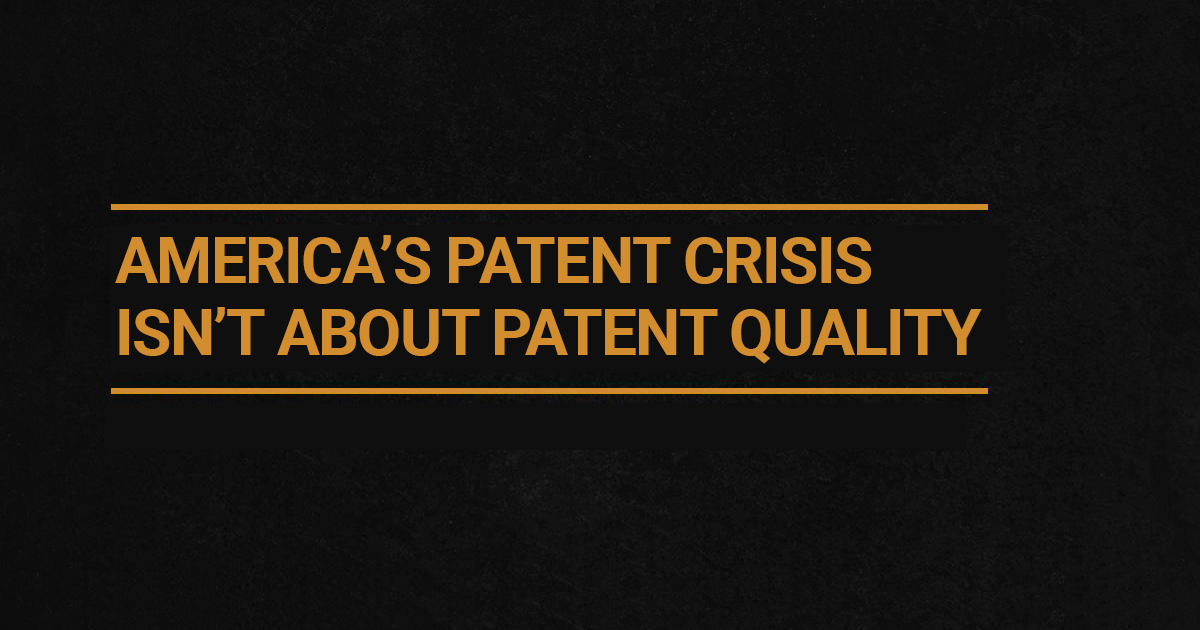America’s Patent Crisis Isn’t About Patent Quality

Stakeholders throughout the patent system agree that patent quality is a good thing. We all want the U.S. Patent and Trademark Office (USPTO) and its examiners to have sufficient resources to perform their exacting work, to keep patent fees from being diverted to other uses and to improve predictability in the patent system.
Unfortunately, proponents of weaker patent rights, primarily incumbent corporate interests seeking to lower their patent licensing costs, appear to be trying to distort the issue of patent quality to serve their own ends. The term “bad patent” or “poor quality patent” is now often used as shorthand to denigrate a patent that may in fact be strong on substance, but that stands in the way of someone who wishes to use the invention protected by the patent without taking out a license to do so.
These anti-patent interests cite statistics about the percentage of patents declared invalid inlitigation to claim that the United States is in the midst of a patent quality “crisis.” But these statistics involve only the small minority of patents that are reviewed in court and ignore thevast majority of patents that are valid and never seriously challenged.
Experts have noted that the overall patent litigation rate has been remarkably steady for nearly a century, at less than two litigations per 1000 patents issued. That does not at all suggest there is a “crisis” in patent quality that has resulted in a disproportionate number oflawsuits or patents being invalidated.
The true crisis in our patent system is the dire state of Section 101 jurisprudence, the area of law determining what is and what is not eligible for patent protection. For nearly 150 years, Section 101 of the U.S. Patent Act was interpreted to allow inventions to be patented across broad categories and subject matters. These patents incentivized American R&D and innovation and led to countless technological and medical breakthroughs.
Starting in 2010, however, the Supreme Court issued a series of decisions that have upended longstanding settled law and narrowed the scope of patent-eligible subject matter. These decisions have created chaos in the patent world and have left inventors uncertain about what is patentable. Senator Thom Tillis has noted the “madness in this area of law,” citing a case where the courts found the invention of a garage door opener to be too abstract to patent. The courts have so muddled the interpretation of Section 101 that something sufficiently concrete that you can literally drop it on your foot can now be considered an abstract concept ineligible for patenting.
Meanwhile, our foreign competitors are granting patents on many inventions that are now unpatentable here. A 2017 study of 18,000 patent applications rejected in the United States found that nearly 1700 were granted in the European Union or China, or both. A World Intellectual Property Organization (WIPO) report further documented that among leading patent offices, the USPTO was among those that granted the smallest percentage of patent applications – fewer than 35% of all applications processed in 2018 – and the share of rejected applications was among the highest.
Restoring clear patent rights is essential to maintaining a strong and healthy U.S. innovation ecosystem. That, in turn, will help U.S. innovators keep up with the fierce international competition to develop the technologies so critical to the future of U.S. national security, including artificial intelligence, advanced computing and 5G. In many of these areas, U.S. companies are competing against state actors who operate without regard to market forces. In fact, in its final report released in March, the National Security Commission on Artificial Intelligence (NSCAI), an independent body established to develop recommendations for advancing AI and other critical technologies in the U.S., concluded that China is poised to “fill the void” left by weakened U.S. intellectual property protections, particularly for patents. We can’t afford to allow that to continue.
So yes, patent quality is important, and we must provide the USPTO with the resources it needs to carefully weigh patent applications and make consistent, defensible and predictable decisions. But the real patent crisis we face is the weakening of patent protections in the U.S., including the inability of innovators to get patents for their new inventions under Section 101.
We encourage all members of Congress to focus their attention on this real patent crisis.
